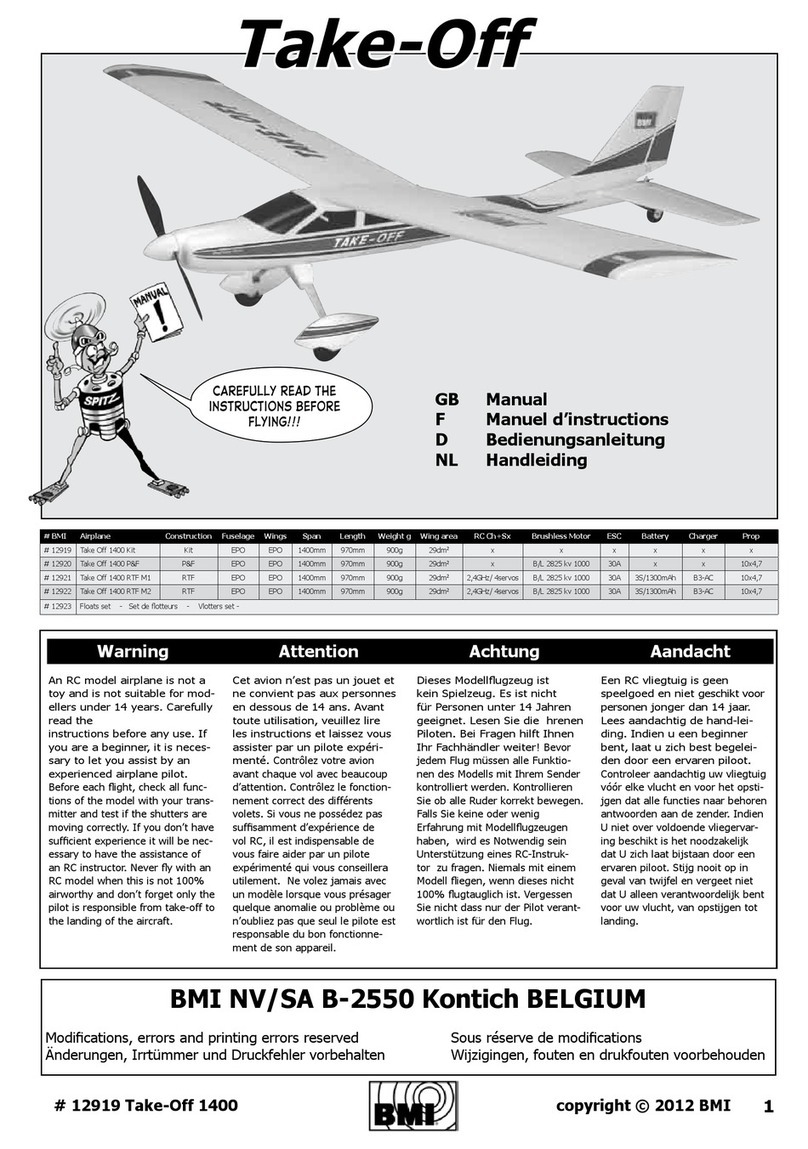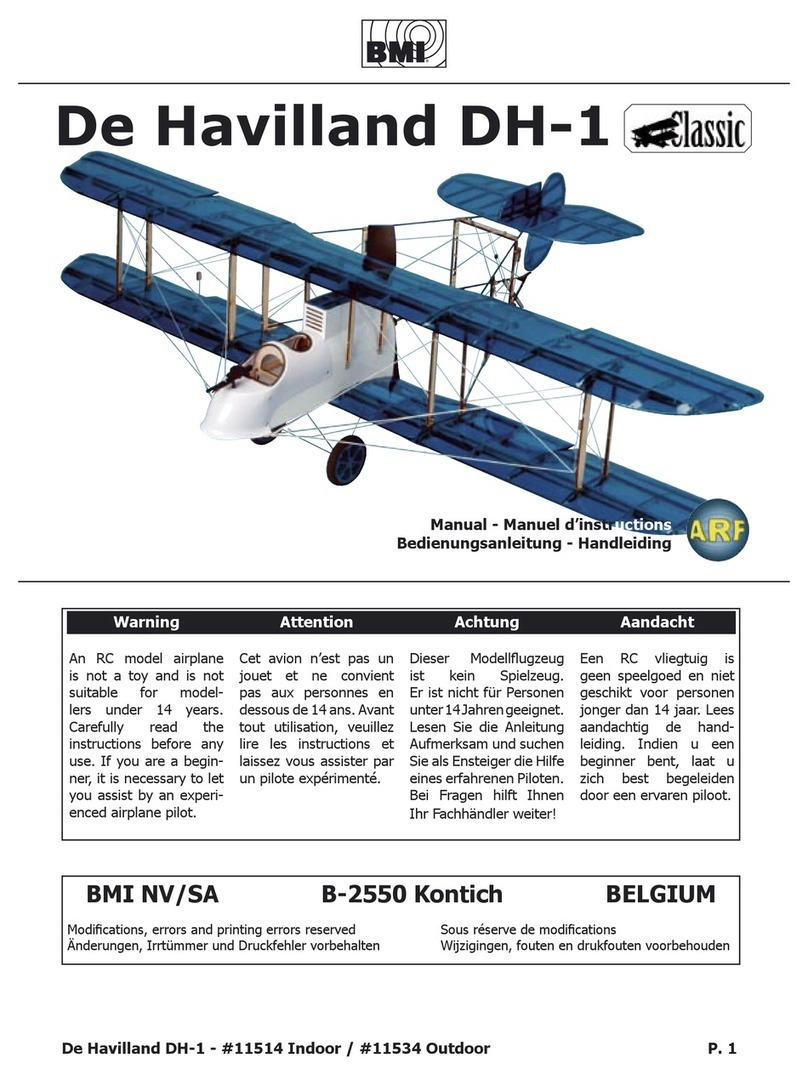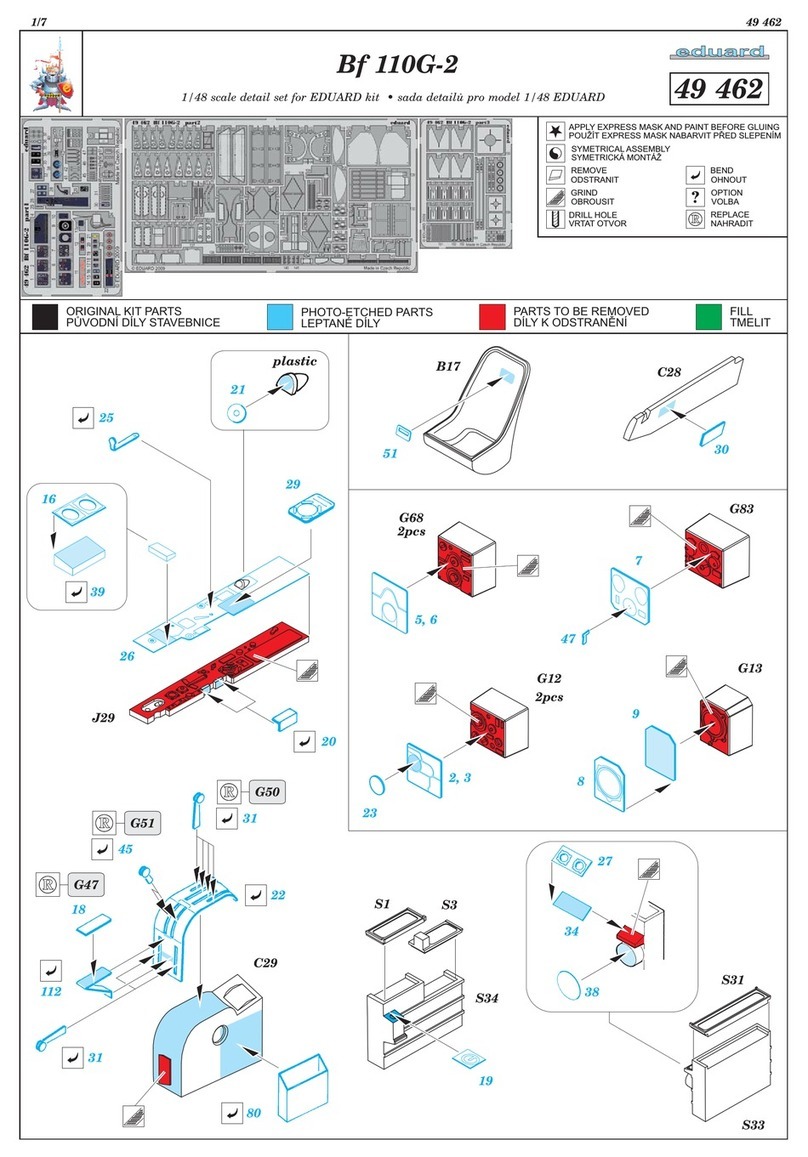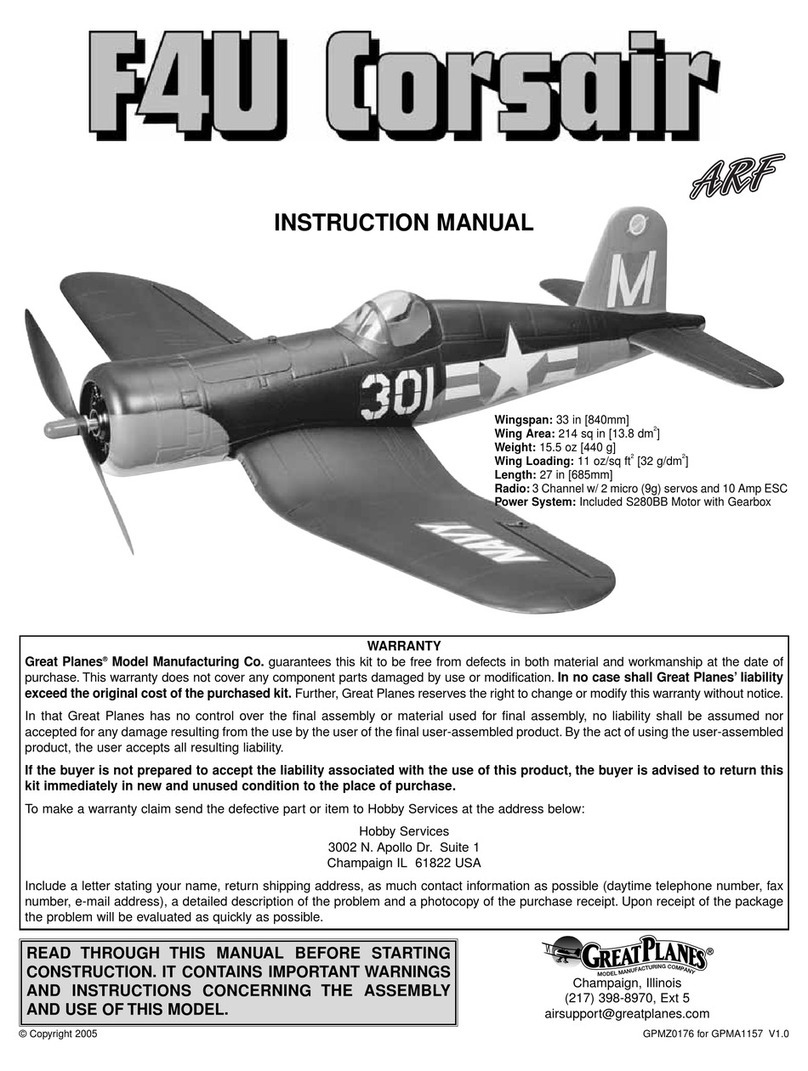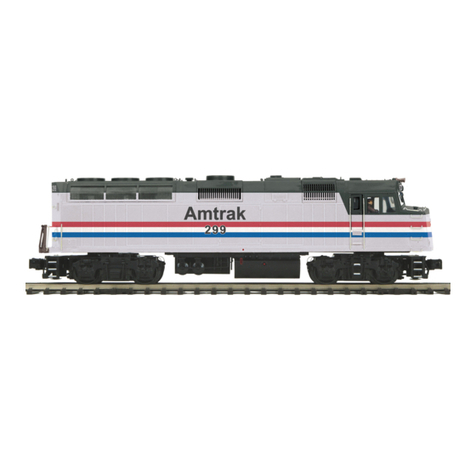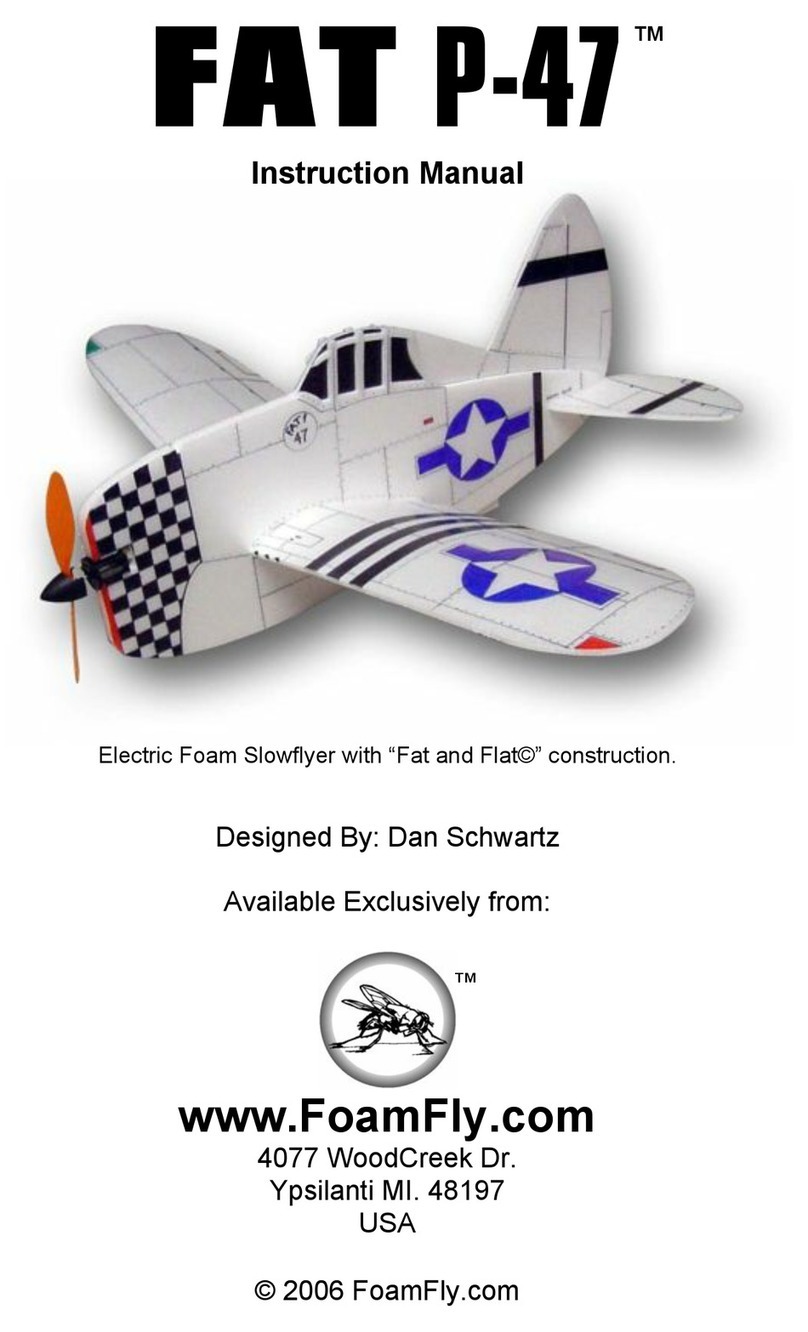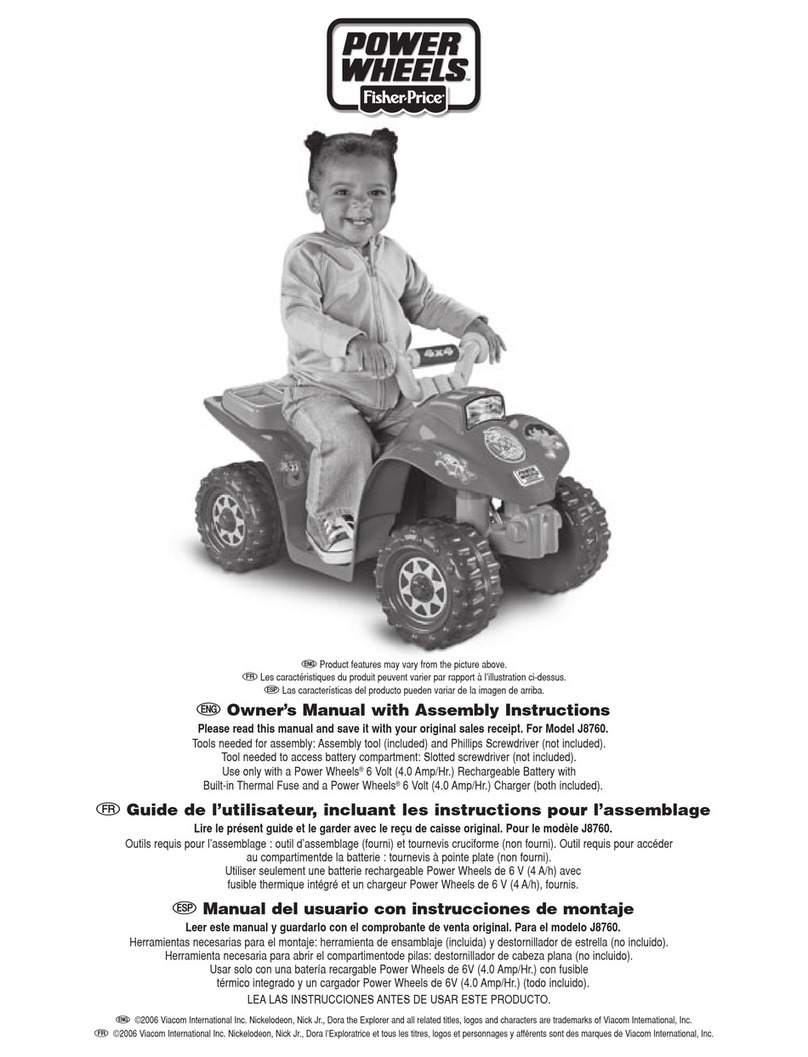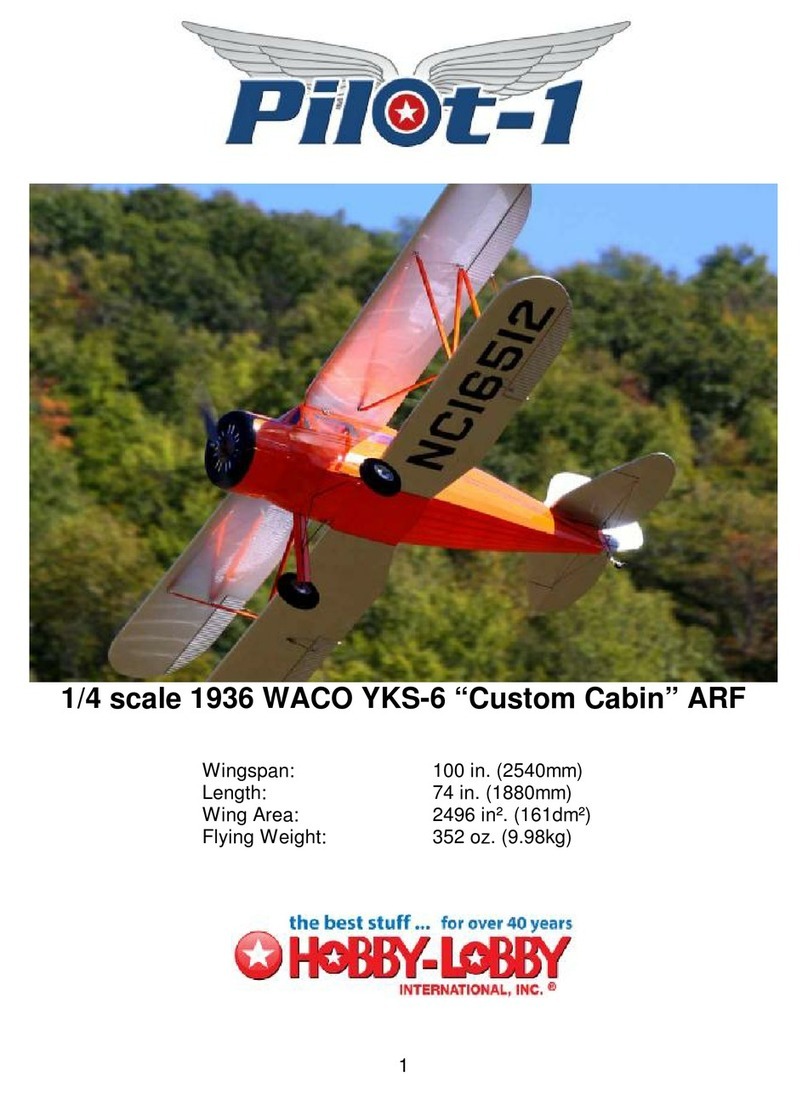BMI Aquila User manual

# 12783 Aquila copyright © 2008 BMI 1
BMI NV/SA B-2550 Kontich BELGIUM
Modications, errors and printing errors reserved Sous réserve de modications
Änderungen, Irrtümmer und Druckfehler vorbehalten Wijzigingen, fouten en drukfouten voorbehouden
Aquila
GB Manual
F Manuel d’instructions
D Bedienungsanleitung
NL Handleiding
An RC model airplane
is not a toy and is not
suitable for model-
lers under 14 years.
Carefully read the
instructions before any
use. If you are a begin-
ner, it is necessary to let
you assist by an experi-
enced airplane pilot.
Cet avion n’est pas un
jouet et ne convient
pas aux personnes en
dessous de 14 ans. Avant
toute utilisation, veuillez
lire les instructions et
laissez vous assister par
un pilote expérimenté.
Dieses Modellugzeug
ist kein Spielzeug. Es ist
nicht für Personen un-
ter 14 Jahren geeignet.
Lesen Sie die Anleitung
aufmerksam und suchen
Sie als Anfänger die Hilfe
eines erfahrenen Piloten.
Bei Fragen hilft Ihnen Ihr
Fachhändler weiter!
Een RC vliegtuig is
geen speelgoed en
niet geschikt voor perso-
nen jonger dan 14 jaar.
Lees aandachtig de hand-
leiding. Indien u een
beginner bent, laat u
zich best begeleiden
door een ervaren piloot.
Warning Attention Achtung Aandacht

2copyright © 2008 BMI # 12783 Aquila
1. Specications / Spécications / Technische Daten / Specicaties
Construction Construction Aufbau Constructie ARF
Fuselage Fuselage Rumpf Romp F/G
Wings Ailes Tragächen Vleugels Balsa
Span Envergure Spannweite Spanwijdte 1700 mm
Length Longueur Länge Lengte 1250 mm
Wing area Surface alaire Flächeninhalt Vleugeloppervlakte 32 dm³
Take off weight gewicht Poids de la machine Gewicht Fliegfertig Vliegklaar gewicht 3200 g
Recommended servos Servos recommandés Empfohlene Servos Benodigde servo’s 6x
Recommended Motor Moteur recommandé Empfohlener Motor Aanbevolen motor 2T- .46
Recommended Controller ESC recommandé Empfohlener Regler Aanbevolen regelaar 4T- .60
Propeller 2Cy/4Cy Hélice 2T/4T Luftschraube 2T/4T Propeller 2T/4T 10x6 ~ 11x6
Recommended Motor Moteur recommandé Empfohlener Motor Aanbevolen motor # 85555
Recommended Controller ESC recommandé Empfohlener Regler Aanbevolen regelaar # 85508
Prop - Electro Hélice électro Luftschraube elektro Propeller electro 13 X 8
Battery Accu Akku Batterij # 18174
CAUTION
Caution measures
Use your radio controlled equipment only for
the operations it has been made for.
Avoid ying near to high-tension lines and
during rainy and/or at windy days. Avoid y-
ing in crowded areas
While reading your manual, you will see the
following symbols. Always pay special atten-
tion to the paragraphs where these symbols
are depicted and always respect their signi-
cance.
Strictly prohibited
Test and verify
Precautions during ight
Never use the same frequency as some-
one else in your running area. Using the
same frequency at the same time (either
if it is AM, FM or PCM) can cause serious
accidents, whether it’s ying, driving or
sailing.
Do not y outdoors by rainy or windy days
or at night. When ying in the rain, water
wil penetrate into the transmitter and will
cause either faulty operation, lack of con-
troll and cause a crash.
Always extend the antenna to its full length
to get the best possible transmission.
Always extend the receiver antenna and
hang it next to the fuselage if you want
to obtain a transmission that is better
then the 5-10 meters with the rolled up
antenna.
Always test the R/C set before
use. Any malfunction in the R/C
set or model may cause a crash.
Before starting the engine, check that
the direction of operation of each servo
matches the operation of its control stick.
If a servo does not move in the proper
direction, or operation is abnormal, do not
y the model.
PRECAUTIONS
Précautions d’usage
Utilisez votre ensemble radio uniquement
pour l’usage auquel il est destiné.
Ne volez pas prés des lignes à haute tension,
pendant les orages, à proximité du public.
Lors de la lecture de votre manuel vous ren-
contrerez ces deux symboles
Respectez leur signication.
Fortement déconseillé
Tester et vérier
Sécurité en vol
Ne volez jamais simultanément avec un
autre modèle ayant la même fréquence.
Ceci causera un crash. Utiliser deux ou
plusieurs ensembles sur la même fré-
quence génère des interférences tant en
FM ou PCM.
Ne volez jamais la nuit, sous la pluie ou par
grand vent. L’eau peut pénétrer dans l’émet-
teur et provoquer des courts-circuits, une
panne ou le mauvais fonctionnement de
l’émetteur et la perte de votre modèle.
Déployez toujours l’antenne de votre
émetteur au maximum pour obtenir une
portée maximale. Déployez l’antenne de
votre récepteur et xez le le long du fuse-
lage an d’obtenir une portée plus grande
que 5-10 mètres.
Testez toujours le bon fonctionnement de
votre radio ainsi qu’un test de portée avant
chaque séance de vol, moteur en marche.
Vériez toujours le sens de déplacement
des servos. Si ceux-ci ne fonctionnent pas
correctement, bruit bizarre ou ultra lents,
frétillement intempestif ne faites pas voler
votre modèle et vériez l’anomalie.
VORSICHT
Vorsichtmassnahme
Benutzen Sie Ihre R/C Fernsteuerung nur für
die dafür vorgesehenen Anwendungen.
Fliegen Sie niemals in der Nähe von Hoch-
spannungsleitungen oder bei widrigen
Witterungsbedingungen, wie z.B. Regen,
Gewitter oder stärkerem Wind.
Das Modell vorsichtig betreiben, wenn sich
Menschen oder Tiere in der Nähe benden.
Halten Sie ausreichend Abstand zwischen
den Menschen bzw. Tieren.
Beim lesen Ihrer Anleitung sehen Sie die
folgenden Symbole. Achten Sie immer
besonders auf die Abschnitte wo diese
Symbole angezeigt werden und respektieren
Sie ihre Bedeutung.
Aussdrücklich verboten
Testen und überprüfen
Vorsichtsmassnahmen während des
Fluges
Prüfen Sie, ob der von Ihnen genutzte Fre-
quenzbereich frei ist. Fliegen Sie niemals,
wenn Sie nicht sicher sind, ob der Bereich
frei ist. Zur gleichen Zeit die gleiche Fre-
quenz benutzen (ob AM, FM oder PCM)
kann ernsthafte Unfälle verursachen.
Fliegen Sie niemals bei widrigen Wit-
terungsbedingungen, wie z.B. Regen,
Gewitter oder stärkerem Wind oder bei
Dunkelheit. Beim Fliegen im Regen dringt
Wasser in den Empfänger. Dadurch kann
ein Kurzschluss entstehen der ernsthafte
Störungen und einen Absturz verursachen
kann.
Ziehen Sie die Senderantenne vollständig
aus. Falls nicht vollständig ausgezogen hat
der Sender nur eine beschränkte Reich-
weite. Antenne des Senders vollständig
abwickeln wenn Sie eine grössere Reich-
weite als 5-10 Meter erreichen wollen.
Vor dem Flugbeginn immer Empfänger,
Sender und Servos auf unregelmässig-
keiten überprüfen. Auch die Reichweite
der Fernsteuerung muss vor dem Flugbe-
ginn überprüft werden. Fliegen Sie nicht
mit diesem Modell, falls die Servos oder
Steuerung nicht ordnungsgemäss funkti-
onieren.
OPGEPAST
Voorzichtmaatregelen
Gebruik uw radiobesturing enkel voor de toe-
passingen waaroor het ontwikkeld werd.
Vlieg nooit in de buurt van hoogspannings-
kabels, tijdens storm of in de nabijheid van
publiek.
Bij het doornemen van deze handleiding zal u
de volgende symbolen opmerken. Respecteer
steeds hun betekenis.
Uitdrukkelijk verboden
Testen en controleren
Voorzichtmaatregelen tijdens de vlucht
Vlieg nooit wanneer een ander telegeleid
voertuig zich op uw frequentie bevindt,
ongeacht of het een AM, FM of PCM fre-
quentie is. Dit zal immers tot een ongeval
leiden.
Vlieg nooit ‘s nachts, bij regenweer of har-
de wind. Water dringt immers in uw ont-
vanger en kan tot een kortsluiting leiden.
Dit leidt dan tot een storing en het verlies
van controle van het model.
Trek steeds uw antenna volledig uit voor
een optimale reikwijdte. De opgerolde an-
tenne van de ontvanger heeft een maxi-
male reikwijdte van 5-10 meter. Indien u
een grotere reikwijdte wenst dient u de
antenne langs de romp af te wikkelen.
Vooraleer het model te gebruiken, dient u
eerst de goede werking van uw zender en
de reikwijdte ervan te testen. Controleer
steeds de servo-uitslag. Vlieg nooit indien
de servo’s niet correct functioneren, geluid
maken of traag zijn.

# 12783 Aquila copyright © 2008 BMI 3
3. Kit content / Contenu de kit / Baukasteninhalt / Verpakkingsinhoud
We guarantee this product to be free of
defects in materials and workmanship at the
moment of purchase. This guarantee doesn’t
cover any component or piece demolished
into use, modications or deteriorations
following from the application of adhesives
or other products not mentioned in the
instructions. In no case our compensation
will exceed the purchase value of the product.
We reserve the right to change or modify
this guarantee without previous notice. As
we have no control on the nal assembly
and on the components used when assem-
bling the kit, no responsibility will be assured
or assumed for any damage resulting from
the bad use of the model kit. By using this
preassembled model the user assumes the
total responsibility.
Cette machine est garantie contre tout vice
de construction d’usine au moment de l’achat.
Cette garantie ne couvre as les composants
détruits lors de l’usage de la machine ou, les
modications de l’ensemble ainsi que de la
détérioration due à l’utilisation de colles ou
autres produits non spéciés dans la notice.
Nous nous réservons le droit de changer ou
modier les clauses de cette garantie sans
préavis.
Wir garantieren, dass dieses Modell zum
Zeitpunkt des Kaufes frei von Produktions-
oder Materialfehlern ist. Diese Garantie
deckt keine Bauteile oder bei der Benutzung
beschädigten Teile zufolge Änderungen oder
Beschädigungen, die durch den Gebrauch
von anderen als in der Betriebsanleitung
erwähnten Materialen entstanden sind.
Sobald das Modellugzeug in Betrieb
genommen wird, übernimmt der Benutzer alle
daraus enstehende Haftung. Reklamationen
aufgrund unsachgemässer Behandlung
oder Schadensersatzforderungen aufgrund
falscher Anwendung dieses Modells müssen
zurückgewiesen werden, da der praktische
Betrieb ausserhalb unseres Einussbereiches
liegt.
Gefeliciteerd met uw aankoop. Dit model
werd ontwikkeld door modelbouwers en ge-
bouwd door onze ingenieurs met het doel
een toestel met uitzonderlijke vliegeigen-
schappen te verwezenlijken. Het is belangrijk
dat u de tijd neemt om aandachtig deze mon-
tagehandleiding tot het einde te lezen.
Als u vragen heeft of als een uitleg u niet
duidelijk is, kan u altijd contact opnemen met
uw plaatselijke dealer.
Dit is een hoog technisch product, waarin
de nieuwste technologische ontwikkelingen
toegepast werden.
To assemble this model some
tools are needed:
• Sharp hobby knife
• Needle nose pliers
• Philips screwdriver
(large and small)
• Triangle
• Scissors
• Wire cutter
• Epoxy
Following items are needed
for operation:
• Servo: 6x # 801532
• Motor: 2CY: # 5316, 4T:# 5352)
• Propeller: 10x6~11x6
• Brushless motor # 85555
• Brushless ESC # 85508
• Propeller electro: 13 x 8
• Battery: # 18174
• RX: # 81538 (35 Mhz)
An d’assembler ce modèle,
veuillez utiliser
les outils suivants:
• Couteau de modélisme
• Pince à becs
• Tournevis Philips
(grand et petit)
• Equerre à dessin
• Ciseaux
• Pinces coupantes
• Epoxy
Les articles suivants sont ne-
cessaire pour l’utilisation:
• Servo: 6x # 801532
• Motor: 2T: # 5316, 4T:# 5352)
• Hélice: 10x6~11x6
• Brushless motor # 85555
• Brushless ESC # 85508
• Hélice électro: 13 x 8
• Battery: # 18174
• RX: # 81538 (35 Mhz)
Folgende Werkzeuge
sind erforderlich zum Bauen
dieses Modells:
• Modellbaumesser
• Flachzange
• Schraubenzieher
(gross und klein)
• Winkelhaken
• Schere
• Seitenschneider
• Epoxy
Folgende Teile sind erforder-
lich für den Gebrauch:
• Servo: 6x # 801532
• Motor: 2T: # 5316, 4T:# 5352)
• Luftschraube: 10x6~11x6
• Brushless motor # 85555
• Brushless ESC # 85508
• Luftschraube elektro: 13 x 8
• Akku: # 18174
• RX: # 81538 (35 Mhz)
Voor het bouwen van dit
model dient u volgend gereed-
schap te gebruiken:
• Modelbouwmes
• Bektang
• Kruisschroevendraaier
(groot en klein)
• Geodriehoek
• Schaar
• Kniptang
• Epoxy
Volgende onderdelen zijn
noodzakelijk voor het gebruik
van uw toestel:
• Servo: 6x # 801532
• Motor: 2T: # 5316, 4T:# 5352)
• Propeller: 10x6~11x6
• Brushless motor # 85555
• Brushless ESC # 85508
• Propeller electro: 13 x 8
• Batterij: # 18174
• RX: # 81538 (35 Mhz)
2. Warranty / Garantie / Garantie / Waarborg

4copyright © 2008 BMI # 12783 Aquila
5. Assembly / Assemblage / Zusammenbau / Montage
5.1 Aileron / Querruder / Rolroer
Assemble the right-hand wing rst.
Connect the aileron to the wing with 3
hinges. Insert the hinges halfway into
the aileron. Test t the ailerons. If the
hinges don’t remain centered, put a
pin through the middle of the hinge.
Remove the pins. Adjust the aileron so
that there is a a small gap (thickness
of paper) between the aileron and the
wing.
Apply drops of CA on the top and
bottom of each hinge. Let the CA dry
and do not use activator. Repeat this
procedure on the left aileron.
Montez d’abord l’aile droite. Joignez
l’aileron à l’aile avec les 3 charnières.
Insérez les charnières à moitié dans
l’aileron. Fixez les charnières à l’aide
d’une aiguille si nécessaire.
Enlevez les aiguilles. Ajustez l’aileron
de façon à ce qu’il y ait un espace
limité entre l’aileron et l’aile. A l’aide
de colle cyano collez les charnières
d’ailerons. Assemblez le côté gauche
de la même façon.
Zuerst (R) Tragäche montieren.
Querruder verbinden mit 3 Scharniere.
Scharniere die Hälfte einschieben.
Sollten die Querruder nicht befestigt
bleiben, vorläug montieren mit
Nadel.
Nadel entfernen. Zwischen Tragäche
und Querruder soll nur ein kleines
Loch (Papiergrösse) übrig bleiben.
Alle Scharniere mit Sekundenkleber
festkleben. Sekundekleber trocknen
lassen und kein Activator benutzen.
Dieses Verfahren wiederholen (L).
Eerst de rechtervleugel monteren.
Rolroeren met 3 scharnieren be-
vestigen. Scharnier de helft inschuiven.
Indien ze niet bevestigd blijven, tijdelijk
met naalden monteren. Naalden
verwijderen. Tussen de vleugels en
de rolroeren mag maar een kleine
opening (ter grootte van een papiertje)
zichtbaar blijven. Iedere scharnier met
secondenlijm vastkleven. Laten drogen
en vooral geen activator gebruiken.
Zelfde procedure voor (L) gebruiken.
4. Used pictogramms / Explication pictogrammes / Verwendete Pictogrammen
Apply 2 components glue
Appliquez de la colle 2 composants
2 Komponentenkleber anbringen
Pay close attention here
Faites bien attention
Achtung bitte
Apply C.A. glue
Appliquez de la colle CA
Sekundenkleber anbringen
Cut off shaded portion
Coupez partie indiquée
Teil abschneiden
Drill holes with the specied diameter
Forrez des trous au diamètre indiqué
Löcher bohren mit dem angedeuteten Durch-
messer
Assemble left and right sides the same way
Assemblez le côté gauche et droit de la même
façon
Rechte und Linke Seite gleich montieren
Purchase separately
Achetez séparément
Nicht enthalten
Ensure smooth non-binding movement while
assembling
Faites attention que le mouvement soit bien
libre
Bitte beachten Sie dass die Teile sich frei bewe-
gen

# 12783 Aquila copyright © 2008 BMI 5
5.2 Aileron servo/ Servo d’aileron / Querruder servo / Rolroerservo
Cut out the slot for the servo.
Use 4 metal screws to x the servo.
Repeat this procedure for the right
wing.
Découpez les trous des servos.
Utilisez 4 vis pour xer le servo.
Assemblez le côté droit de la même
façon.
Öffnung für den Servo ausschneiden.
Servo mit 4 Schrauben festmachen.
Idem für (R) Tragäche.
Opening voor de servo uitsnijden.
Met 4 schroeven de servo bevestigen.
Zelfde procedure voor rechtse vleugel
volgen.
Install the aileron pushrods. Put a
nylon control horn in place as shown.
Align it with the servo. Mark the
location for the screw holes. Drill the
holes with the correct diameter.
Mount the nylon control horn with
machine screws. Use the threaded
pushrod wire. Thread a nylon clevis
onto the thread. Install a silicone clevis
retainer onto the clevis.
Install the clevis on the aileron control
horn.
Center the aileron servo. Align the
pushrod and bend it accordingly.
Install the wire onto the servo arm as
shown in the sketch.
Fixez les guignols sur les gouvernes.
Alignez-le avec le servo.
Marquez l’endroit pour forer le trou.
Forez les trous au diametre adéquat.
Montez les guignols avec des vis.
Placez la chape en nylon sur la tringle.
Installez la sécurité en silicone sur la
chape.
Fixez la chape sur le guignol d’aileron.
Positionnez le servo d’aileron au
neutre. Mettez en place la tringle
et pliez la.Installez la tringle sur le
palonnier de servo comme montré.
Querruder Schubstange montieren.
Nylon Anlenkung montieren wie
abgebildet.
Servo alignieren. Stelle für Löcher
bestimmen. Löcher bohren.
Schubstange mit Gewinde benutzen.
Nylon Gabelkopf montieren.
Gabelkofpstopper auf den Gabelkopf
montieren. Gabelkopf auf den Quer-
rudern montieren.
Querruderservo zentrieren.
Schubstange alignieren und biegen.
Servoanlenkung montieren wie ab-
gebildet.
De rolroerpushrods monteren
Monteer de roerhoorn zoals afgebeeld.
Aligneer het met de servo.
De plaats voor de bevestigingsgaten
bepalen. Gaten met de juiste diameter
boren. Gebruik de pushrod met
draadstang. Nylon kwiklink monteren.
De kwiklinkstopper op de kwiklink
monteren.
Kwiklink aan de rolroeren bevestigen.
Rolroerservo monteren.
Pushrod correct uitmeten, buigen en
aanbrengen. Servoaansturing op de
servoarm monteren zoals afgebeeld.
5.3 Aileron pushrods / Tringlerie / Schubstange / Rolroerpushrods

6copyright © 2008 BMI # 12783 Aquila
5.4 Rudder / Gouverne de direction / Seitenruder / Richtingsroer
5.5 Install elevator servo / Installation du servo de profondeur Höhenruderservo
montieren / Servo van het hoogteroer monteren
Insert the stab tubes into the fuselage,
centering the tubes. Once centered,
mark the tubes where they meet the
fuselage on both sites.
Install the elevators to the stab with
three hinges per elevator, using the
same method as used on the ailerons
(step 5.1).
Install the completed elevators to the
tail of the fuselage with two tubes,
making sur they are properly centered.
Glue the elevators to the fuselage
using epoxy.
Insérez les tubes d’alignement dans
le fuselage et centrez les et marquez
ceux-ci de chaque côté du fuselage.
Installez les gouvernes de profondeur
au moyen de 3 charnières de chaque
côté et utilisant la même méthode que
pour la xation des ailerons (5.1).
Glissez le stabilisateur complet sur
les deux tubes en vous assurant qu’il
sont toujours bien centrés et collez le
stabilisateur en place à la colle epoxy.
Führen Sie die beiden Kohlefaserrohre
durch die dafür vorgesehenen Öff-
nungen an der Rückseite des Rumpfes.
Zentrieren Sie die beiden Rohre und
kennzeichnen Sie deren Position zum
Rumpf mit einem Stift. Montieren Sie
das linke Höhenruder an das Leitwerk
wie auch beschrieben bei der Installa-
tion der Querruder (Punkt 5.1).
Wiederhohlen Sie diese Vorgangsweise
für das rechte Höhenruder.
Installieren Sie die in der vorigen Etap-
pe montierten Höhenruder über die
beiden Stangen an das Heck. Überprü-
fen Sie ob diese gut zentriert sind. Kle-
ben Sie beide Höhenruder mit Epoxy
an den Rumpf.
Monteer de twee carbonbuizen
doorheen de gaten, voorzien achteraan
de romp. Centreer de twee buizen en
markeer hun positie ten opzichte van
de romp met een stift.
Monteer het linkse hoogteroer aan
de stabilo, gebruikmakend van drie
scharnieren zoals beschreven bij de
installatie van de rolroeren (stap 5.1).
Herhaal deze stap voor het rechtse
hoogteroer.
Plaats het in de vorige stap
gemonteerde hoogteroer over de
twee buizen aan de staart. Doe dit
zowel voor het linkse als het rechtse
hoogteroer. Let er op dat beide buizen
goed gecentreerd zijn, rekening
houdend met de eerder aangebrachte
merktekens. Lijm beide hoogteroeren
vast aan de romp, gebruik makend van
epoxylijm.
Install the rudder to the stab with 3 hinges using the same method used on the
aileron.
Utilisez deux charnières et suivez la même procedure que ci-dessus (5.1)
Seitenruder montieren. Beide Scharniere installieren und verfahren wie oben
(5.1).
Monteer het hoogteroer met drie scharnieren. Gebruik daarvoor dezelfde
methode als gebruikt in stap (5.1).

# 12783 Aquila copyright © 2008 BMI 7
5.6 Elevator pushrods/ Tringlerie gouverne de profondeur / Steuerungen Höhenruder
Hoogteroer aansturingen
Put the three pushsrods through the
molded pushrod-exits that you will
nd at the rear end of the fuselage.
Connect the pushrods with the control
horns of both elevators and rudder, us-
ing the same method as described in
step 5.3.
Passez les trois commandes d’asservis-
sement dans les découpes prévus que
vous trouveriez à l’arrière du fuselage.
Connectez ensuite chaque commande
au guignol respectif (2x gouverne de
profondeur, 1x gouverne de direction),
comme décrit dans 5.3.
Führen Sie die 3 Steuerstangen in die
dafür vorgesehenen Löcher am Ende
des Rumpfes ein. Verbinden Sie jede
Steuerstange mit dem jeweiligen Ru-
derhorn ( 2x Höhenruder, 1x Rich-
tungsruder) wie eher beschrieben in
Punkt 5.3 .
Voer de drie stuurstangen door-heen de
voorgevormde gaten die u achteraan
de romp vindt. Verbind elke stuurstang
met zijn desbetreffende roerhoorn (2x
hoogteroer, 1x richtingsroer), zoals
eerder beschreven in stap 5.3.
5.7 Installation of the winglets / Installation des ‘winglets’ / Montage der
Tragächenendstücken / Montage van de vleugeltippen
Cut away the covering at the end of the wing tip. Glue the tip to the wing with
epoxy and attach the tip using two metal screws.
Découpez l’entoilage en dessous du ‘winglet’. Collez l’ensemble à l’époxy et
xez les à l’aide de deux vis.
Schneiden Sie ein Teil der Bespannung der Flügelspitze ab. Kleben Sie die Flü-
gelspitze an den Flügel mit Epoxy und befestigen Sie diese mit 2 Metallschrau-
ben.
Snij een deel van de bespanning van de vleugeltip weg. Verlijm de vleugeltip
aan de vleugel met epoxy en maak deze vast met twee metalen schroefjes.
5.8 Engine installation * / Installation du moteur * / Montage vom Motor*
Motormontage*
* Option

8copyright © 2008 BMI # 12783 Aquila
1. In the rewall, you will nd some
molded lines. These can be used as a
reference for the engine mount. Ex-
tend the lines with a pen to have a
clearer view.
2. Drill four holes in the corners of the
pattern.
3. Use four metal screws to attach the
mount. There is a difference in the di-
mension of the pats. When looking at
the fuselage from the front, the left pat
is 4mm and the right pat is 7mm.
4. Position your engine onto the engine
mount. Let the engine rest on the en-
gine mount rails and center the engine
and engine mount. Tighten the engine
mount bolts. With your engine still
resting on the rails, position the engine
so that the distance from the rewall to
the front of the engine thrust washer is
145mm. Slide the cowl onto the fuse-
lage to be sure the engine is extending
far enough out of the cowl.
5. Mark the four holes for the engine
bolts on the engine mount. Drill four
holes in the mount and use a tap to
thread the holes. The motor needs to
be installed upside-down.
1. Sur le couple pare-feu se trouvent
des repères pour l’installation du mo-
teur.
2. Forez des trous dans les 4 coins sur
les repères.
3. A l’aide de quatre vis + écrous in-
stallez les supports moteur. Faites
attention: il y a différence entre le
support gauche et le support droit.
Lorsque vous vous trouvez en face la
distance est de 4 mm à gauche et de
7 mm à droite.
4. Installez votre moteur sur le bâti-
moteur et centrez celui-ci. Fixez le
avec 4 vis + écrous en tenant compte
que le plateau d’hélice se trouve à 145
mm distant du couple pare-feu. Glis-
sez le capot-moteur en place an de
s’assurer qu’il ne touche pas l’hélice.
5. Marquez et forez les 4 trous pour
xer votre moteur, tête en bas.
1. Im Motorspant benden sich Richtli-
nien für die Installation des Motors.
2. Bohren Sie 4 Löcher in die Ecken der
Sjablone.
3. Benutzen Sie 4 Metallschrauben um
die Motorträger zu befestigen. Aufge-
past, es gibt ein Unterrschied zwischen
dem linken und dem rechten Träger.
Wenn Sie vor dem Rumpf stehen,
muss der Abstand zum linken Träger
4mm, der Abstand zum rechten Träger
7mm betragen
4. Stellen Sie den Motor auf die Träger
und zentrieren Sie diese. Der Abstand
zwischen dem Motorspant und der
Luftschraube muss 145mm betragen.
Schieben Sie die Motorhaube über den
Rumpf um zu prüfen ob der Motor weit
genug aus der Motorhaube reicht.
5. Markieren Sie auf dem Motorträger
die 4 Löcher für die Motorschrauben.
Bohren Sie 4 Löcher in den Motorträ-
ger und benutzen Sie einen Gewinde-
bohrer für die Löcher. Der Motor muss
umgedreht montiert werden.
1. In de vuurplaat bevinden zich ref-
erentie
lijnen voor de motorinstallatie.
2. Boor 4 gaten in de hoeken van het
sjabloon.
3. Gebruik 4 metalen schroeven om
de motorbevestiging vast te maken.
Opgelet, er is een verschil tussen de
linkse en de rechtse drager. Wanneer
je voor de romp staat dient de afstand
tot de linker steun 4mm te bedragen
en die tot de rechter steun 7mm.
4. Plaats de motor op de motorsteun
en centreer deze. Schroef de motorvij-
zen vast. De afstand van de vuurplaat
tot de schroefplaat aan de voorzijde
van de motor dient 145mm te zijn.
Schuif de motorkap op de romp om na
te gaan of de motor ver genoeg uit de
motorkap komt.
5. Markeer op de motorsteun de vier
gaten voor de motorbouten. Boor vier
gaten in de motorsteun en gebruik een
tap om de gaten te maken. De motor
dient ondersteboven gemonteerd te
worden.
5.9 Installation electric motor* / Montage du moteur électrique / Einbau vom elek-
trischen Motor / Montage van de elektromotor
* Option

# 12783 Aquila copyright © 2008 BMI 9
1. Drill four holes in the corners of the
pattern and attach the motor mount to
the fuselage with 4 screws.
2. Attach the motor to the mount with
four screws.
3. Pay attention that the distance from
the rewewall to the front motorwash-
er is 145 mm.
4. For an optimal cooling it is recom-
mended to install the ESC inside the
motor mount.
1. Forez quatre trous commme indi-
qué et fixez le support moteur au fu-
selage.
2. Fixez le moteur sur son bâti-mo-
teur.
3. La distance entre le plateau d’hélice
et le couple pare-feu est de 145 mm.
4. Pour un meilleur refroidissement
nous vous conseillons d’installer le
controleur à l’intérieur du bâti-moteur.
1. Bohren Sie 4 Löcher in die Ecken der
Sjablone und befestigen Sie den Mo-
torträger mit 4 Schrauben und Muttern
an den Rumpf.
2. Befestigen Sie den Motor an den
Motorträger mit 4 Schrauben.
3. Vorsicht: der Abstand des Motor-
spants zur Luftschraube muss 145mm
sein.
4. Für eine optimale Kühlung sollte
der Motorregler am besten in den Mo-
torträger montiert werden.
1. Boor 4 gaten in de hoeken van het
sjabloon en bevestig de motorsteun
met 4 schroeven en 4 moeren aan de
romp.
2. Bevestig de motor aan de motor-
steun met 4 schroeven.
3. Let op: de afstand van de vuurplaat
tot de schroefplaat dient 145 mm te
bedragen.
4. Voor optimale koeling kan de mo-
torregelaar best in de motorsteun ge-
monteerd worden.
1. Drill a hole at the bottom of the
molded groove in the wheel pant so
that the axle can pass through.
2. Install the wheel by inserting the
nose wheel axle trough the wheel
pant. Make sure the wheel can move
freely.
3. Fix the axle mounting the nylon
plate with two screws.
4. Drill four holes to attach the nose
gear bearing. Insert the axle into the
nose gear bearing.
5. Drill one hole to allow the push-
rod for the nose gear wheel to pass
through.
1. Forez un trou afin de faire passer la
commande de gaz.
2. Installez la roue avant et son axe
dans le cache-roue et veillez que la
roue tourne librement.
3. Fixez le cache-roue au moyen du
cavalier et 2 vis.
4. Forez 4 trous pour fixer le bloc de
base du train avant et inserez-y la
jambe.
5. Forez un trou dans l’axe pour la
commande de la direction du train
avant.
1.Loch bohren wie abgebildet
2.Das Rad anschrauben und darauf
achten, dass sich das Rad frei bewe-
gen kann.
3.Bohren Sie 4 Löcher um den Halter
des Landegestells zu befestigen. An-
schliessend die Achse durch den Halter
schieben.
4. Eine Öffnung machen wodurch die
Steuerung des vordersten Rads er-
möglicht wird.
1. Boor een gaatje onderaan de sleuf
zodat de as er door kan.
2. Schroef het wiel aan de wielverkled-
ing en zorg ervoor dat het wiel vrij kan
bewegen.
3. Boor 4 gaatjes om de houder van
het landingsgestel te bevestigen. Steek
vervolgens de as door de houder.
4. Maak een opening waardoor de aan-
sturing van het voorste landingswiel
kan gedaan worden.
5.10 Installation of the nose landing gear / Installation de la roue de nez
Bugrad montieren / Installatie van het neuswiel

10 copyright © 2008 BMI # 12783 Aquila
5.11 Installation of the main landing gear / Installation du train principal
Montierung vom Fahrwerk / Montage van het landingsgestel
Position the landing gear in place
and mark the three holes to attach
the landing gear. Drill the holes.
Attach the main landing gear
with 3 screws to the fuselage.
Repeat this procedure on the right
side.
Positionnez et marquez les 3 points
d’attache. Forez les 3 trous et fixez
chaque jambe d’atterrissage avec
3 vis.
Das Landegestell genau positionieren
und die 3 Löcher markieren. Anschlies-
send die 3 Löcher bohren und das Lan-
degestell mit 3 Schrauben wie abgebil-
det montieren.Wiederholen Sie diesen
Vorgang für die rechte Seite.
Been van landingsgestel op de cor-
recte manier positioneren en duid de 3
gaten aan. Boor vervolgens de 3 gaten
en monteer het landingsgestel zoals
afgebeeld met 3 schroeven. Herhaal
dezelfde procedure voor de rechter
zijde.
Assemble the fuel tank as shown in the
picture. When tightening the center
screw, make sure not to overtighten it.
Hold the tank in place inside the fuse-
lage by two rubber bands around the
tank. Attach the rubber bands to the
plywood that supports the tank.
Montez le réservoir comme indiqué
et veillez à ne pas serrer trop fort la
vis du centre. Attachez le réservoir au
moyen de deux anneaux caoutchoux,
accrochés au couple en contreplaqué
supportant le réservoir.
Montieren Sie den Benzintank wie ab-
gebildet. Achten Sie darauf, dass Sie
die mittlere Schraube nicht zu fest an-
ziehen. Befestigen Sie den Tank mittels
zwei Gummiringen. Befestigen Sie die
beiden Gummiringe an den Tank. Ver-
binden Sie die Flügel mit dem Rumpf.
Monteer de benzinetank zoals afge-
beeld. Let er op de middelste schroef
niet te vast aan te draaien. Hou de
tank op zijn plaats d.m.v. twee rubber
ringen. Maak de rubberen ringen vast
aan de bevestiging voor de tank.
Verbind de vleugels met de romp.
5.12 Fuel tank installation / Installation du réservoir / Montage vom Benzintank
Montage van brandstoftank

# 12783 Aquila copyright © 2008 BMI 11
5.13 Installation of the wings / Installation des ailes / Montage der Tragächen /
Montage van de vleugels
Join the wings and fuselage
Use two nylon screws to attach the
wings and fuselage. Then glue the
wings and fuselage with epoxy.
Joignez les ailes au fuselage et fixez
les au moyen de deux vis nylon. Collez
ensuite.
Benutzen Sie zwei Nylon-Luftschrau-
ben um die Flügel mit dem Rumpf zu
verbinden. Benutzen Sie Epoxy um die
Flügel an den Rumpf zu kleben.
Gebruik twee nylon schoeven om de
vleugels met de romp te verbinden.
Gebruik epoxy lijm om de vleugels aan
de romp vast te lijmen.
The following four push rods need to
be connected (gas power); elevator,
rudder, front landing gear and throttle.
The front landing gear pushrod can be
connected to the rudder servo. Position
the servo’s as shown in the picture.
Les 4 commandes peuvent être con-
nectées: gaz-moteur, profondeur,
direction et roue avant. Installez les
servos comme indiqué.
Die folgenden 4 Steuerungen müssen
angeschlossen werden (Benzinmotor);
Höhenruder, Seitenruder, Bugfahrwerk
und Gashebel. Die Steuerung des Bug-
fahrwerkes kan angeschlossen wer-
den an den Servo des Seitenruders.
Schliessen Sie die servos an wie ab-
gebildet.
De volgende aansturingen dienen
aangesloten te worden (ontploff-
ingsmotor); hoogteroer, richtingsroer,
stuurwiel voor en tag. De aansturing
voor het stuurwiel kan op de richting-
sroerservo aangesloten worden. Plaats
de servo’s zoals afgebeeld.
5.14 Installation of the servos and electronics / Installation des servos et de
l’électronique / Einbau vom Servos und Elektronic / Installatie van de servo’s
en electronica
5.15 Installation of the canopy / Montage de la verrière / Kabinenhaube montieren
Montage de la verrière
Use six metal screws to attach the
canopy to the upper fuselage.
Fixez la verrière avec 6 vis comme
indiqué sur la photo.
Kabinenhaube mit 6 Schrauben am
Rumpf befestigen.
De canopy met 6 schroeven aan de
romp bevestigen.

# 12783 Aquila copyright © 2008 BMI 12
5.16 Installation of the motorcowl / Montage du capot-moteur / Motorhaube
montieren / Montage de motorkap
1. Position the cowl on the fuselage
and make sure the engine is centered
in the opening in the front of the
cowl.
2. Install the appropriate propeller for
your engine and spinner.
1. Positionnez le capot moteur sur le
fuselage et assurez-vous qu’il est bien
centré à l’avant.
2. Installez l’hélice et fixez le cône
d’hélice.
1. Die Motorhaube über den Rumpf in-
stallieren und darauf achten, dass der
Motor zentriert ist in der Öffnung vor
der Motorhaube.
2. Die richtigen Propeller installieren
für Ihren Motor und Spinner.
1. Plaats de motorkap op de romp en
zorg ervoor dat de motor voor de mo-
torkap gecentreerd is.
2. Installeer de juiste propeller voor de
motor en spinner.
5.19 Center of gravity / Centre de gravité / Schwerpunkt / Zwaartepunt
5.18 Control surface travels / Débattements des gouvernes / Ruderausschläge /
Roeruitslag
Controle surface travels:
Ailerons: ± 18 mm
Rudder: ± 25 mm
Elevator: ± 15 mm
CG: 85 mm from leading
edge.
Débattements des gou-
vernes :
Ailerons : ± 18 mm
Dérive : ± 25 mm
Profondeur: ± 15 mm
Centrage: 85 mm du bord
d’attaque contre le fuselage.
Ruderausschlag:
Querruder: ± 18 mm
Seitenruder: ± 25 mm
Höhenruder: ± 15 mm
Schwerpunkt: 85 mm von
Prolvorderkante (Rumpf-
seite)
Roeruitslagen:
Rolroeren: ± 18 mm
Richtingsroer: ± 25 mm
Hoogteroer: ± 15 mm
Zwaartepunt: 85 mm van de
aanvalsboord.
5.17 Adjust the wing & fuselage conguration as in the diagrams / Vérication de la
symétrie de l’assemblage / Überprüfung von Symmetrie vom Flugmodell / Con-
trole van de vleugelsymmetrie
This manual suits for next models
1
Other BMI Toy manuals
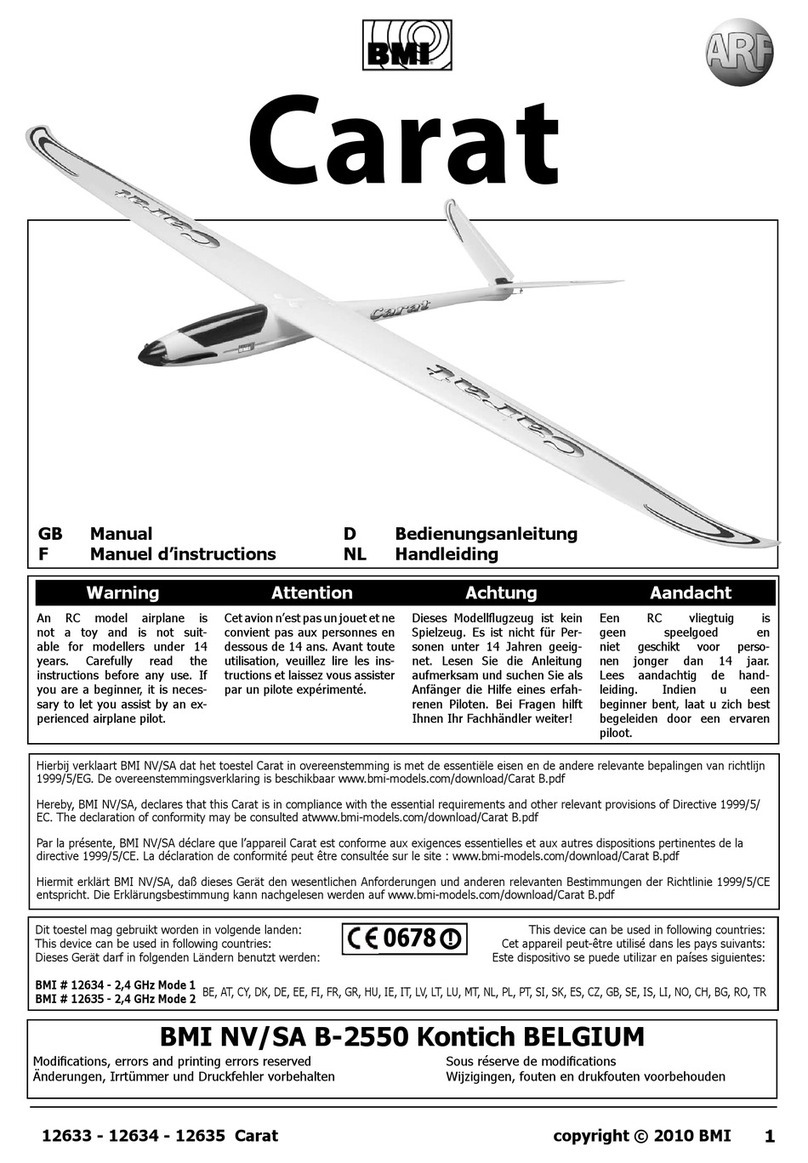
BMI
BMI Carat User manual
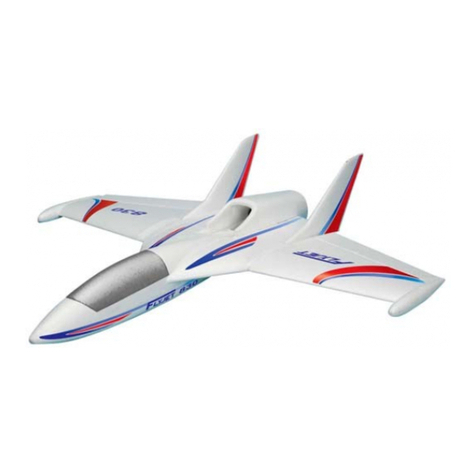
BMI
BMI EPO-FLEX FlyJet x-83 User manual
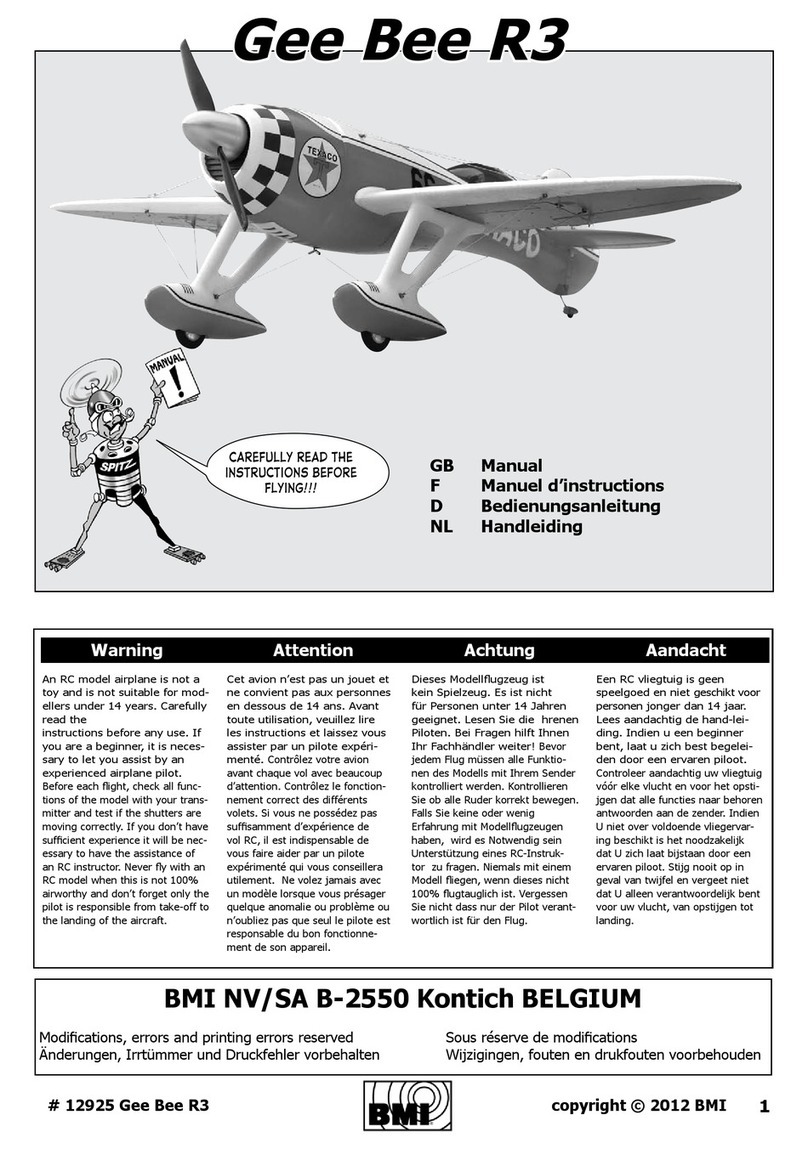
BMI
BMI Gee Bee R3 User manual
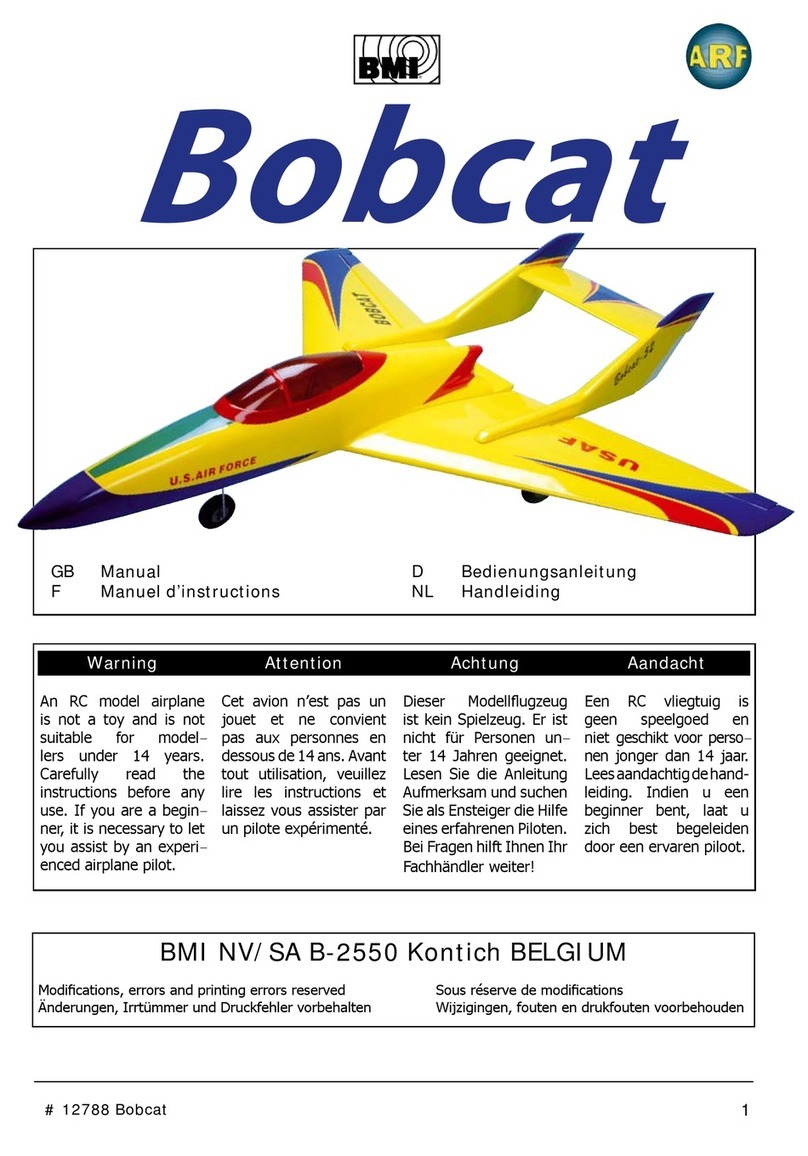
BMI
BMI Bobcat User manual
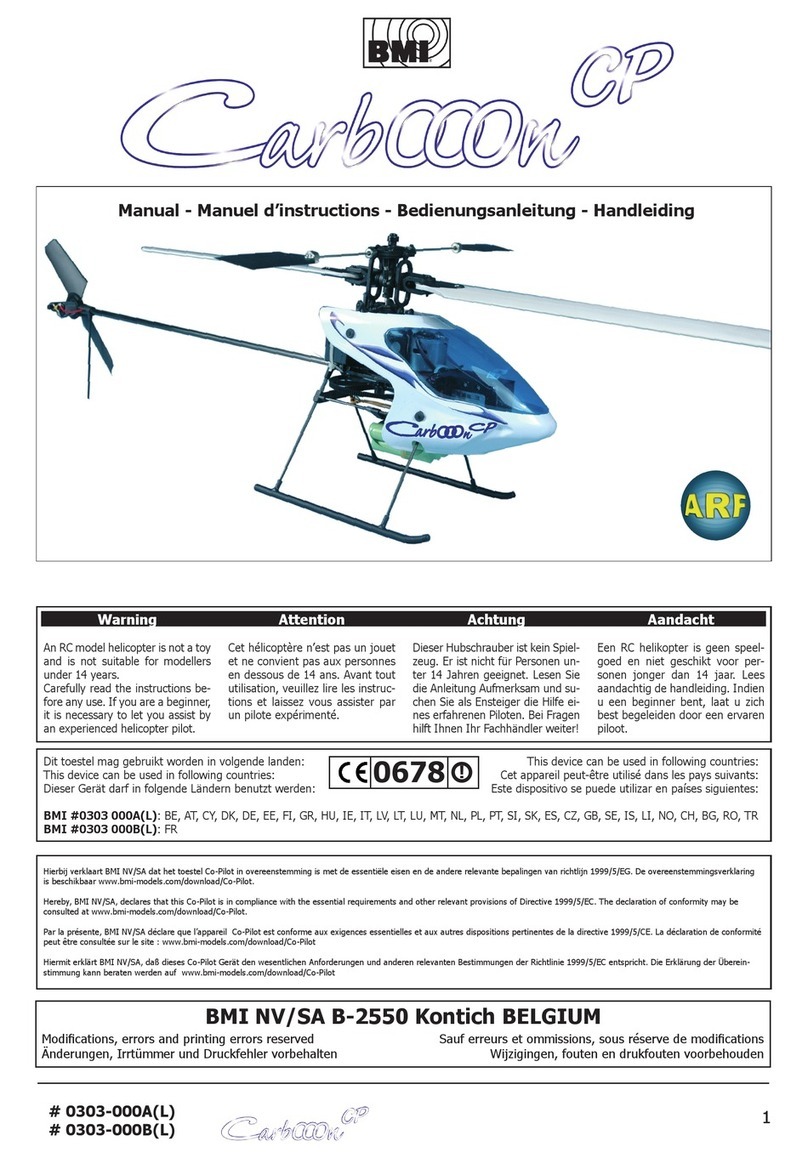
BMI
BMI CarbOOOn CP User manual

BMI
BMI Carbooon 450-S User manual

BMI
BMI Sports 182 EP User manual
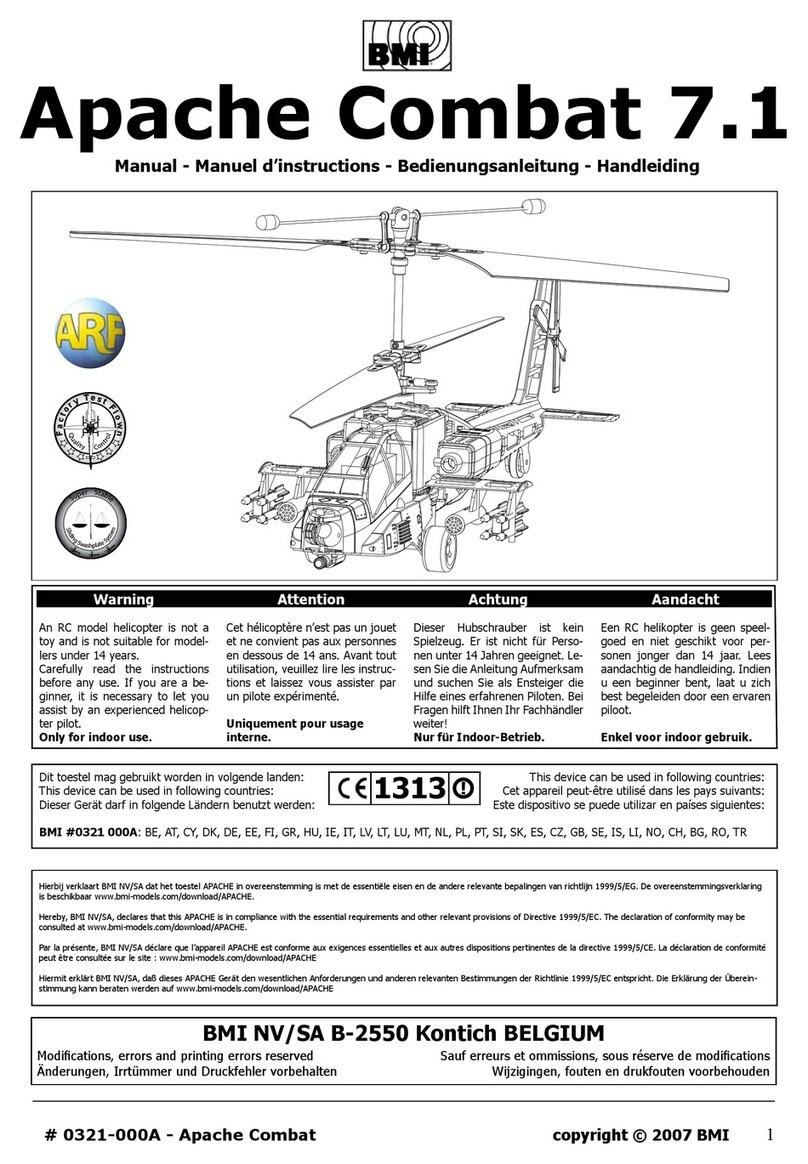
BMI
BMI Apache Combat 7.1 User manual
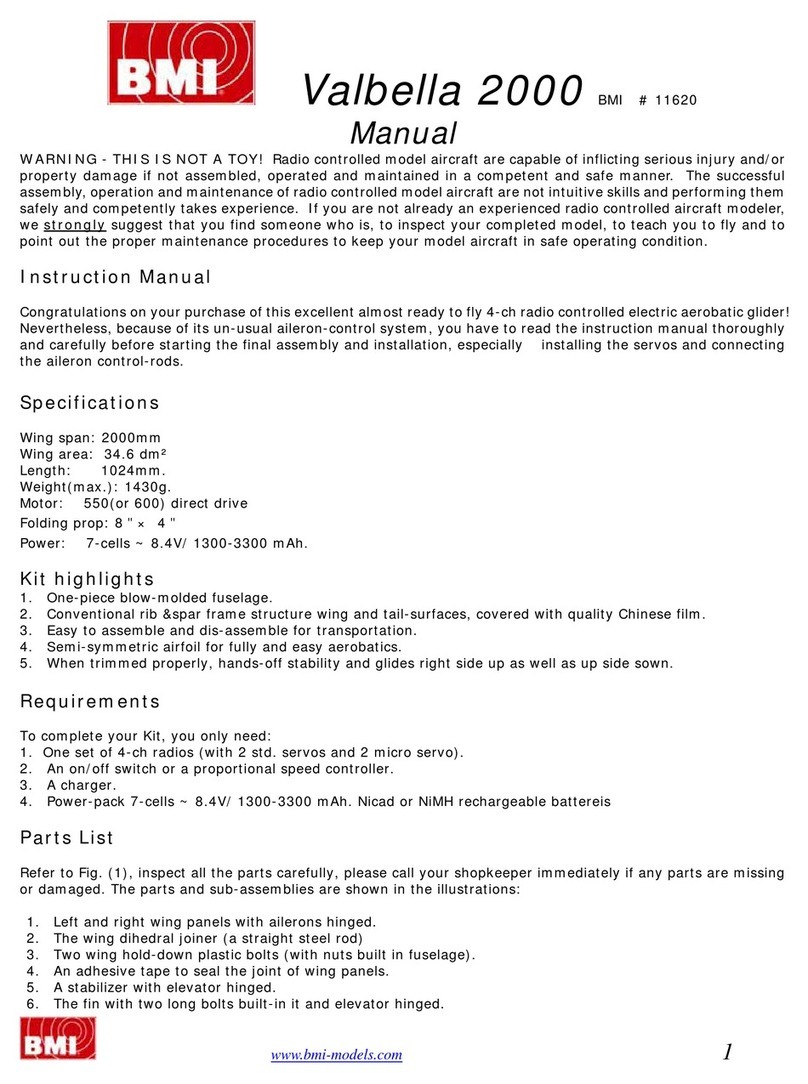
BMI
BMI Valbella 2000 User manual

BMI
BMI Focke Wulf 190 User manual
Popular Toy manuals by other brands
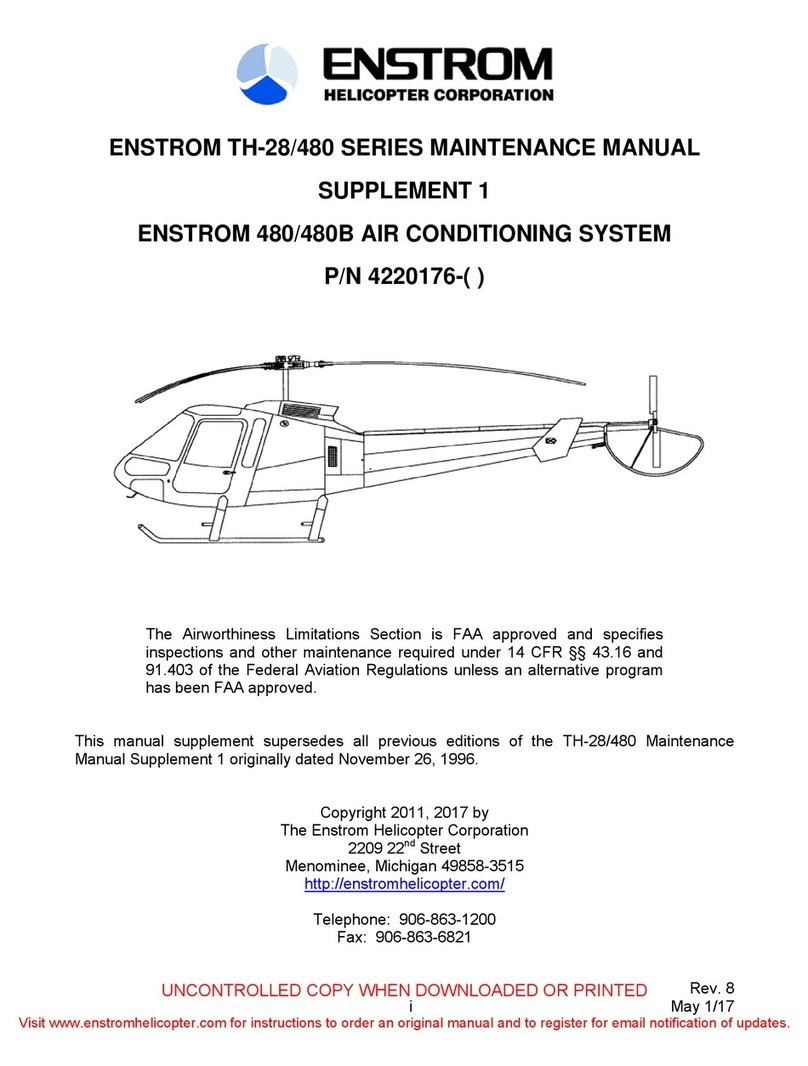
ENSTROM
ENSTROM TH-480 Series Supplement manual

Mocka
Mocka Kids Shopping Trolley Assembly instructions

School Zone
School Zone Little Scholar Mini quick start guide
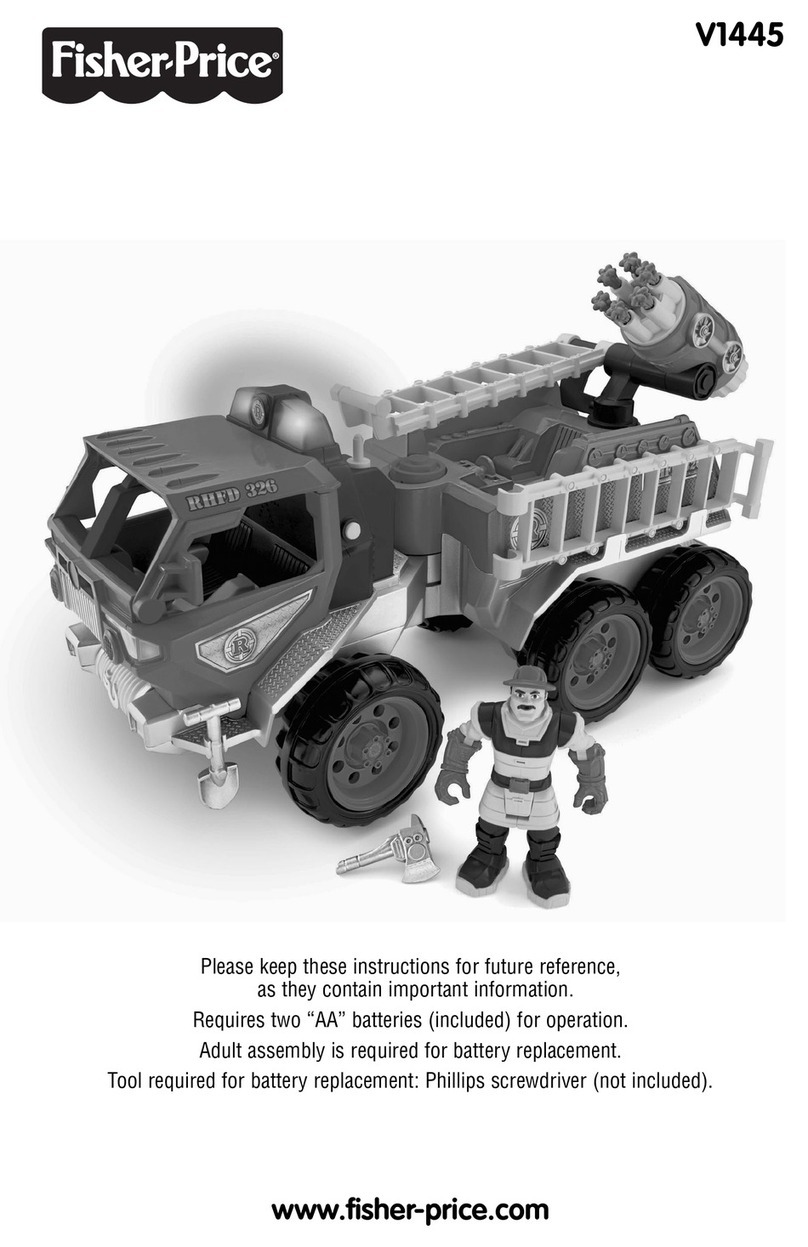
Fisher-Price
Fisher-Price V1445 user manual
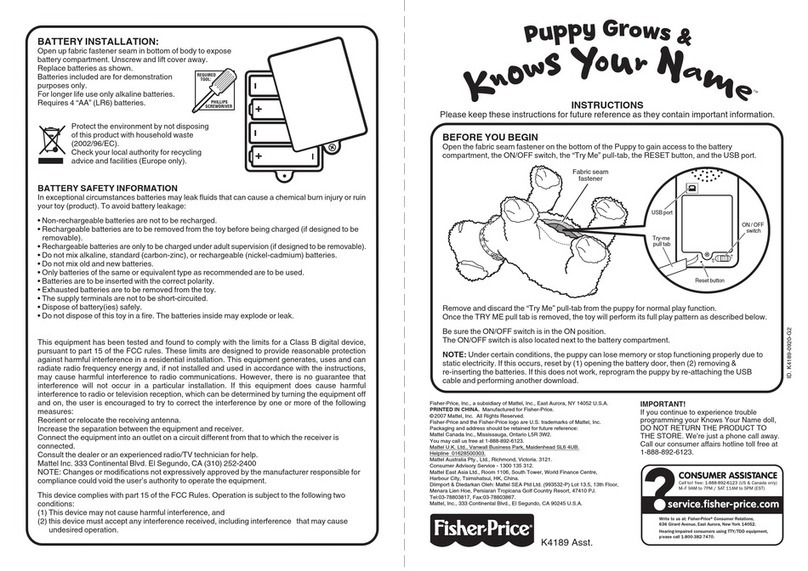
Fisher-Price
Fisher-Price Puppy Grows & Knows Your Name instructions

Radio Shack
Radio Shack Reef Skimmer owner's manual



